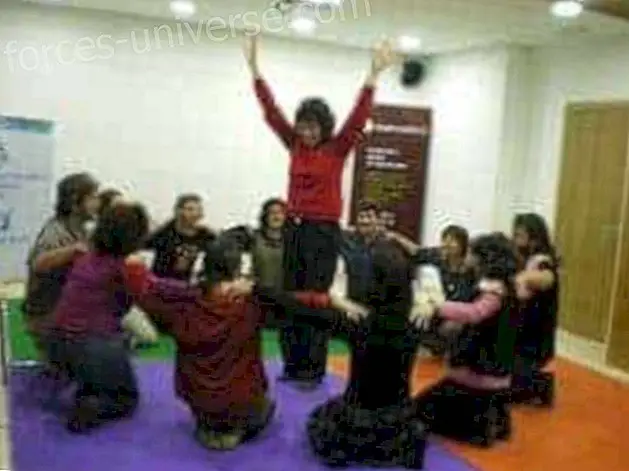While participating in a learning process in “Soft Skills”, I observed that a group of participants were distracted using their cell phones, others were sleeping sitting in their chairs, and a good part of students were talking softly, in order to Not be heard.
Drawing conclusions from the topic that the exponent was revealing, and from the reality that he lived and observed in the participants, I asked myself the following question, why the tutor of this Training, observing the current scenario of his students, has not implemented a strategy of didactic and festive learning, which moves this training to a more conducive and active environment
I invite you to accompany me and reflect with me, on the course of training in real didactic and festive learning environments . All those who have to do with the teaching and learning processes, we must ensure for our students, disciples or students, knowledge acquisition environments outside the usual four walls of a classroom.
Training beyond the classroom, different learning scenarios

If to develop a training process, I told you right now, I wait for you in the classroom! What would you think? What would you imagine? Would it make you reluctant and lazy to go to the classroom and receive the training?
Probably, your imaginary would associate the classroom, to a hierarchical space and regulated by coexistence criteria imposed by the teacher of the shift, in which realities of power over students, disciples or formants are evidenced . Unfortunately, since ancient times we have sold this idea of a classroom; and surely, I would end up just giving the training to a classroom full of chairs, unless the proposed learning process is mandatory, so everyone should arrive.
Think, do we need to be forced to acquire knowledge, training and discipline? Or, on the contrary, does the teacher have to prepare educational and festive learning strategies that attract attention and invite them to participate?
What is didactic learning?

The teaching is directly linked to the processes that refer to the act of learning, this, to which it is a joint act, between the teacher and the students, in a given context and with the use of some concrete and efficient means and strategies that generate interest .
Let's see some primitive information. The word didactic is derived from the Greek term didaskein, which means teaching ; and of the root t kne, which translates broadly, art . In short, didactics is the art of teaching .
Let's see it this way. Pedagogy supplies the theory ; and the practice, the didactics would provide . The first would be science, and the second would be art, and in turn science. Do you see why the unity of both is important?
Seen in a general way, a bird flight, the didactic learning is constituted by the methodology used, that is, all those procedures, techniques and other resources, used in the teaching process . However, you must differentiate between didactic, general didactic and specific or special didactic learning; Only and exclusively, in this Article, I will make reference to didactic learning, because it is the theme that brings you here with me today.
Worrying about how will it be taught?, is one of the main interests of teaching. Imideo G. Nérici says: “ Didactics is the study of the set of technical resources that are aimed at directing student learning, in order to lead them to reach a state of maturity that allows them to face reality, consciously, efficiently and responsible, to act in it as a participating and responsible citizen. ”
Thus, Fernández Sarramona Tarín, gives didactics an applicative character, extraordinarily practical, although with a speculative theoretical character, however, its practicality is its main reason for existing. He says verbatim: “ Didactics is the branch of pedagogy that focuses on guiding systematic educational action, and in the broadest sense:“ As the total direction of learning ”that is, it covers the study of teaching methods and resources to be applied by the educator or educator to positively stimulate the learning and integral and harmonious training of the students ”
Along these same lines, Luis A. de Mattos says: “ Didactics is the pedagogical discipline of a practical and normative nature whose specific objective is the technique of teaching, that is, the technique of encouraging and effectively guiding students and students in learning “
As you can see, the didactic learning is wide, both from its theoretical significance, and in its application in educational environments of any kind. What will the didactic action be like for the next learning process?
What is festive learning?

Festive learning, rather than a teaching method, must be understood as an internal experience, which is then externalized, by those who have participated in a didactic learning process. Thus, festive learning is an extension of didactic learning .
Let's look at an example of a possible scenario. Andrés, head of the Department of Human Management of a Company, participated in a didactic theme on stress reduction within the Organization. The techniques used to guide the training were apprehended by Andrés, who even, with great joy and efficiency, shared them with the officials of the different areas of this Company .
At first glance, the only thing that can be appreciated is an employee committed to his work; However, seen from festive learning, things would change a bit.
The festive learning has to take the apprentice, to transmit to others, those acquired knowledge, either through the same experiential and didactic techniques, or through others . Ask yourself, do you transmit the knowledge that you are acquiring in your different training processes? Without a doubt to make a mistake, I could say that many do not, why ?, basically, because that learning experience was not acquired with joy and festivity such that It will take you to replicate it in others.
With this evidence, I could tell you that the last name of didactic learning is festive, keeping your full name, festive didactic learning .
Great care! For your next formation process, you will have to go to transmit what you learned, or you will be in charge of your disciples the festive and experiential joy that will lead them to transmit the knowledge that you have made known to them .
From the moment, what teaching techniques will you perform, so that the knowledge that you are going to transmit are festive and are fun to transmit to others?
It's a challenge, right? Do not forget. Didactic learning leads to festive learning . That is to say, those techniques and mechanisms used in your formation processes must have an effect capable of being transmitted by your disciples to other people, achieving that, with joy, happiness and dedication, the formative reason is impregnated .
It's time to change your training processes! When will you start?

Author : William Hern n Estrada P rez, Editor in the Great Family of hermandadblanca.org






